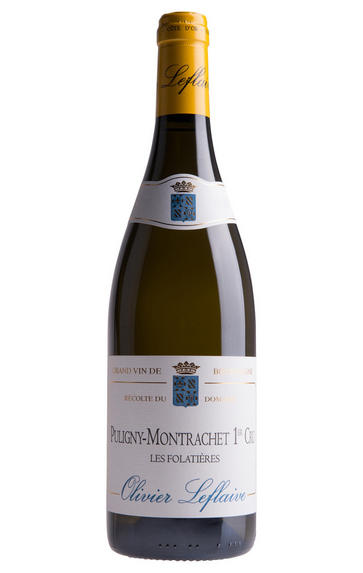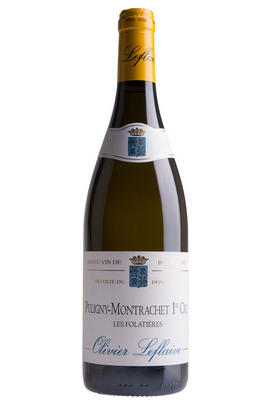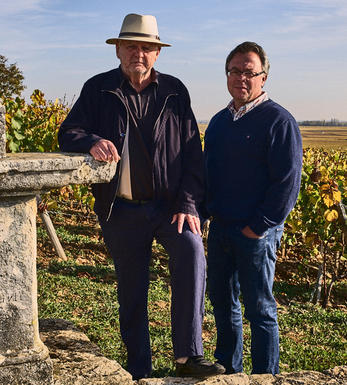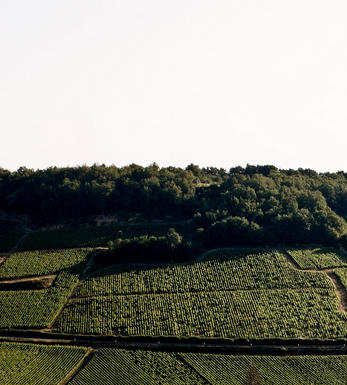
2017 Puligny-Montrachet, Les Folatières, 1er Cru, Domaine Olivier Leflaive, Burgundy

About this WINE

Olivier Leflaive
Olivier Leflaive studied at business school before heading to Paris, where he lived a rather bohemian life in the 1970s. He returned to Burgundy in ’81 to manage Domaine Leflaive with his uncle Vincent and, later, his cousin Anne-Claude.
He set up his own négociant business in ’84, leaving the family domaine a decade later; he gave 15 years’ notice that he would take back his share of the vines.
Winemaker Franck Grux now makes 85-90 different cuvées, vinifying the equivalent of 120 hectares – 17 of which are estate-owned. The focus is on elegance and finesse over power.

Puligny-Montrachet
Puligny was one of two villages (along with Chassagne) which gained permission in 1879 to hyphenate the name of its most famous vineyard, Montrachet, to its own.
The reputation of Puligny-Montrachet is based around its four Grands Crus. Montrachet labels often boast a noble, triumphant 'Le' in front of its name, lest you dare confuse it with any lesser wine. It has much to be proud of, with many considering Montrachet to be the greatest white wine in the world. At its best it has an intensity, complexity and elegance that make you wonder how such a wine could be made from mere grapes.
The luxurious and explosive Chevalier-Montrachet is not quite as deep, although it is probably the next best. Only marginally less impressive, and rather more consistent than Montrachet is the richly textured Bâtard-Montrachet (also shared with Chassagne). Bienvenues-Bâtard-Montrachet is equally good, with the focus on honeyed finesse and exquisite balance rather than richness.
These legendary wines are supported by a host of fabulous Premier Cru vineyards capable of reaching Grand Cru quality. Brimming with flavour and intensity, Le Cailleret and Les Pucelles (which both lie across the road from Le Montrachet) are prime candidates, along with Les Demoiselles, Les Combettes and Folatières.
Sandwiched between the larger Chassagne and Meursault, Puligny produces wines that are more striking than any in the Côte d’Or, portraying a floral elegance alongside a stylish, steely concentration. They are very different to Meursault: more refined and delicate, and less rich.
Village level Puligny-Montrachet from top growers can be very good indeed, but is all too often unexciting and disappointing. Grands Crus normally need at least eight years before they can be broached, and last for 20 or more. Premiers Crus should generally be enjoyed between five and 15 years of age; village wines from three to 10 years.
In theory, you can find red Puligny-Montrachet, but it scarcely exists anymore, and is rarely worth the price tag.

Chardonnay
Chardonnay is often seen as the king of white wine grapes and one of the most widely planted in the world It is suited to a wide variety of soils, though it excels in soils with a high limestone content as found in Champagne, Chablis, and the Côte D`Or.
Burgundy is Chardonnay's spiritual home and the best White Burgundies are dry, rich, honeyed wines with marvellous poise, elegance and balance. They are unquestionably the finest dry white wines in the world. Chardonnay plays a crucial role in the Champagne blend, providing structure and finesse, and is the sole grape in Blanc de Blancs.
It is quantitatively important in California and Australia, is widely planted in Chile and South Africa, and is the second most widely planted grape in New Zealand. In warm climates Chardonnay has a tendency to develop very high sugar levels during the final stages of ripening and this can occur at the expense of acidity. Late picking is a common problem and can result in blowsy and flabby wines that lack structure and definition.
Recently in the New World, we have seen a move towards more elegant, better- balanced and less oak-driven Chardonnays, and this is to be welcomed.


Buying options
Add to wishlist
Description
Picked on the second day of harvest to capture freshness, this is a wine of elegance and refinement. Floral notes accompany a gorgeous touch of spentmatch reduction on the nose, the impression of precision and purity flowing seamlessly onto the palate, which is precise, pure and poised. Vinous sophistication. Drink 2023-2031.
After studying at business school, Olivier Leflaive headed to Paris to live a rather bohemian life during the 1970s, working in music and television. He returned to Burgundy in 1981 to manage Domaine Leflaive with his uncle Vincent and later his cousin Anne-Claude. Having long aspired to work for himself, he set up his own négociant business in 1984 and, upon leaving the family domaine a decade later, he gave 15 years’ notice that he would take back his share of the family vines from 2009. Experienced winemaker Franck Grux now makes between 85 and 90 different cuvées, vinifying the equivalent of 120 hectares, of which 17 are estate. The focus here is on elegance and finesse over power.
Franck emphasised the importance of removing excess shoots and buds on the vine early in the season to ensure yields did not become excessive, a practice he encouraged his growers to follow. The results are evident in the wines, which display wonderful concentration and texture, generosity in the mid-palate, precise, direct fruit and a sapid acidity. The excellent natural balance of the wines made vinification relatively straightforward and has yielded wines which Franck describes as “serious” and, in many respects, comparable to the 2014s. Unless otherwise stated, all wines are domaine.
wine at a glance
Delivery and quality guarantee